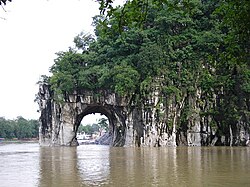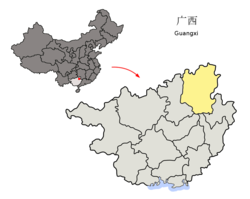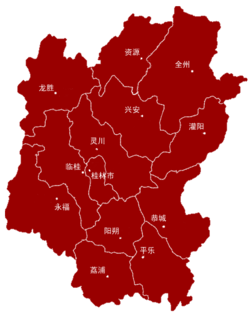Guilin
From Wikipedia, the free encyclopedia
| Guilin | |
| — Prefecture-level city — | |
| Chinese transcription(s) | |
| - Characters | 桂林 |
|---|---|
| - Pinyin | Guìlín |
| Zhuang transcription(s) | |
| - Zhuang | Gveilinz |
| Elephant Trunk Hill, the Symbol of Guilin | |
| Guilin in Guangxi, China | |
| Administrative divisions within Guilin | |
| Coordinates: | |
| Country | China |
| Region | Guangxi |
| Area | |
| - Total | 27,809 km2 (10,737.1 sq mi) |
| Population | |
| - Total | 1,340,000 |
| - Density | 48.2/km2 (124.8/sq mi) |
| Time zone | China Standard (UTC+8) |
| Postal code | 541000 |
| Website | http://www.guilin.gov.cn/ |
Guilin (Chinese: 桂林; pinyin: Guìlín) is a city in China, situated in the northeast of the Guangxi Zhuang Autonomous Region on the west bank of the Li River. Its name means "forest of Sweet Osmanthus", owing to the large number of fragrant Sweet Osmanthus trees located in the city. The city has long been renowned for its unique scenery.
Contents |
[edit] History
In 314 BC, a small settlement was established along the banks of the Li River.
In 111 BC, during the reign of Emperor Wu of the Han Dynasty, Shi An County was established, which could be regarded as the beginning of the city.
In 507 AD, the town was renamed Guizhou.
Guilin prospered in the Tang and Song dynasties but remained a county. The city was also a nexus between the central government and the southwest border, and it was where regular armies were placed to guard that border. Canals were built through the city so that food supplies could be directly transported from the food-productive Yangtze plain to the farthest southwestern point of the empire.
In 1921, Guilin became one of the headquarters of the Northern Expeditionary Army led by Dr. Sun Yat-sen.
In 1940, the city acquired its present name.
In 1981, this ancient city was listed by the State Council as one of the four cities (the other three being Beijing, Hangzhou and Suzhou) where the protection of historical and cultural heritage, as well as natural scenery, should be treated as a priority project.
[edit] Physical setting
- Area: 27,809 km²
- Subtropical region
- Typical karst formation
- Mountains: Diecai Hill (叠彩山), Elephant Trunk Hill (象鼻山), Seven-Star Cave (七星岩), Wave-Subduing Hill (伏波山), Lipu Mountains, The Cat Mountains (猫儿山)and Yaoshan Mountains
- Rivers: Lijiang
- Cave: The Reed Flute Cave (芦笛岩,Seven Star Cave (七星岩)
[edit] Administrative divisions
Guilin administers 17 county-level divisions:
- Five city districts: Xiufeng District (秀峰区), Xiangshan District (象山区), Diecai District (叠彩区), Qixing District (七星区), Yanshan District (雁山区).
- Ten counties: Lingui County (临桂), Yangshuo County (阳朔), Lingchuan County (灵川), Xing'an County (兴安), Quanzhou County (全州), Yongfu County (永福), Ziyuan County (资源), Guanyang County (灌阳), Pingle County (平乐), Lipu County (荔浦).
- Two autonomous counties: Gongcheng Yao Autonomous County (恭城瑶族自治县), Longsheng Autonomous County (龙胜各族自治县).
[edit] People
- Population: 1.34 million
- Urban population: 620,000
- Ethnic groups: Zhuang, Yao, Hui, Miao, Han and Dong
[edit] Climate
- Damp monsoon climate
- Warm and rainy
- Plenty of sunshine and clear division of the four seasons
- Warm winters
- Average temperature: 19°C annually
[edit] Economy
- The GDP per capita was ¥15775 (ca. US$1910) in 2003, ranked no. 125 among 659 Chinese cities.
- Local industry: pharmaceutical goods, tires, machinery, fertilizer, silk, perfume, wine, tea, cinnamon, herbal medicine
- Local agricultural products: Shatian Pomelo, summer orange, Fructus Momordicae, ginkgo, moon persimmon, Lipu Tara, Sanhua Alcohol, pepper sauce, fermented bean curd, Guilin Rice Noodle, water chestnut, grain, fish and dried bean milk cream in tight rolls
[edit] Transportation
Airport: Guilin Liangjiang International Airport Train:Guilin Train Station
[edit] Panorama of Guilin
[edit] Colleges and universities
[edit] Public
- Guilin University of Technology (桂林理工大学)
- Guilin Medical University (桂林医学院)
- Guilin University of Electronic Technology (桂林电子科技大学)
- Guangxi Normal University (广西师范大学)
Note: Institutions without full-time bachelor programs are not listed.
[edit] Attractions

The Jingjiang Princes City is a royal complex dating from the Ming Dynasty that lies near the center of modern Guilin.
Other scenic spots around Guilin include:
- Seven Star Park
- Seven-Star Cave and Ludi (Reed-Flute) Cave
- Camel Mountain and Elephant Trunk Hill
- Piled Festoon Hill
- Crescent Hill
- Fubo Hill
- Nanxi Hill
- Erlang Gorge
- Huangbu (Yellow Cloth) Beach
- Moon Hill
- Longsheng Rice Terrace
[edit] Cuisine
Guilin cuisine is known for its snacks and the use of spices, especially chili. The famous Guilin chili sauce, Guìlín làjiāojiàng (桂林辣椒酱), used widely in cooking by locals,[1] is made of fresh chili, garlic, and fermented soybeans, and is considered one of the city's Three Treasures (桂林三宝). The other two of the Three Treasures are Guilin Sanhua Jiu (桂林三花酒), a variety of rice baijiu, or liquor distilled from rice; and Guilin pickled tofu (桂林豆腐乳).
Guilin rice noodles (桂林米粉; pinyin: Guìlín mǐfěn) have been the local breakfast staple since the Qin dynasty and are renowned for their delicate taste. Legend has it that when Qin troops suffering from diarrhea entered this region, a cook created the Guilin rice noodles for the army because they had trouble eating the local food. Specifically, the local specialty is noodles with horse meat, but this dish can also be ordered without the horse meat. Zongzi (粽子; pinyin: zòngzi), a dumpling made from glutinous rice and mung bean paste wrapped in a bamboo or banana leaf) [2] is another popular delicacy in Guilin.
[edit] In popular culture
- Guilin was used as the planet Kashyyyk in Star Wars Episode III: Revenge of the Sith
- Many scenes from the film The Painted Veil, adapted from the 1925 W. Somerset Maugham novel The Painted Veil were filmed in Guilin and the surrounding area.
- The scenery from the twenty Yuan bill is that of the Li River.
- Guilin is the final area of the video game Shenmue II and the home of Shenhua.
- Guilin was mentioned in the novel The Joy Luck Club as the original home of Suyuan Woo, the mother of the primary narrator of the story, Jing-mei Woo.
[edit] Quotes
- "I often sent pictures of the hills of Guilin which I painted to friends back home, but few believed what they saw."
- - Fan Chengda (Chinese Song Dynasty scholar)
- 桂林山水甲天下 - "Guilin’s scenery is best among all under heaven."
- - popular Chinese saying
[edit] Sister Cities
 - Nishikatsura Town (西桂町), Japan
- Nishikatsura Town (西桂町), Japan - Hastings, New Zealand
- Hastings, New Zealand
The Guilin relationship with the New Zealand city Hastings started in 1977, after a research scientist, Dr Stuart Falconer identified a number of common areas of interest between the two cities, including horticulture and their rural-urban mix.
[edit] Gallery
[edit] See also
- Shenmue II
- Chinese alcoholic beverage
- Li Zongren
- Transportation in Macau
- Bai Chongxi
- Sister City: Nishikatsura Town (西桂町), Japan
[edit] External links
| Wikimedia Commons has media related to: Guilin |
- Chinese Language and Cultrure Learning in Guilin
- Guilin travel guide from Wikitravel
- Official website of Guilin Government
- Guilin Attractions
- Guilin and Lijiang River National Park
- 300 photos from Guilin and Surroundings (Longsheng, Yangshuo, Li Fluss)
- Photos, map and tips about Guilin
- Travel to Guilin photos and map
- Guilin City Map
- Guilin Photos and Gallery
- Local English speaking guides for Guilin and Yangshuo
|
|||||||||||||
















